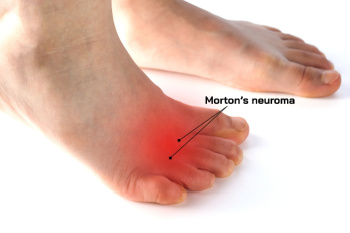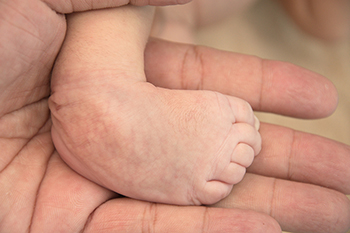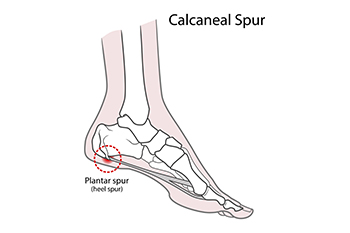Items filtered by date: November 2024
Understanding Morton’s Neuroma

Morton’s neuroma is a painful condition involving the thickening of tissue around a nerve leading to the toes, most commonly affecting the area between the third and fourth toes. It often feels like standing on a pebble or experiencing a burning, tingling pain in the ball of the foot. Causes include repetitive stress or compression, commonly from wearing tight or high-heeled shoes. High-impact activities, flat feet, and bunions also increase the risk of developing Morton’s neuroma. Diagnosis typically involves a physical exam, imaging, and recreating symptoms through pressure on the affected area. Treatments range from footwear modifications, orthotics, and anti-inflammatory medications to more invasive options like corticosteroid injections or, in severe cases, surgery. The outlook is generally positive with proper management, and prevention focuses on wearing supportive, well-fitted shoes and avoiding prolonged foot stress. If you have symptoms of Morton’s neuroma, it is suggested that you visit a podiatrist who can provide a tailored treatment plan for relief.
Morton’s neuroma is a very uncomfortable condition to live with. If you think you have Morton’s neuroma, contact one of our podiatrists of Podiatry Associates of Victoria. Our doctors will attend to all of your foot care needs and answer any of your related questions.
Morton’s Neuroma
Morton's neuroma is a painful foot condition that commonly affects the areas between the second and third or third and fourth toe, although other areas of the foot are also susceptible. Morton’s neuroma is caused by an inflamed nerve in the foot that is being squeezed and aggravated by surrounding bones.
What Increases the Chances of Having Morton’s Neuroma?
- Ill-fitting high heels or shoes that add pressure to the toe or foot
- Jogging, running or any sport that involves constant impact to the foot
- Flat feet, bunions, and any other foot deformities
Morton’s neuroma is a very treatable condition. Orthotics and shoe inserts can often be used to alleviate the pain on the forefront of the feet. In more severe cases, corticosteroids can also be prescribed. In order to figure out the best treatment for your neuroma, it’s recommended to seek the care of a podiatrist who can diagnose your condition and provide different treatment options.
If you have any questions, please feel free to contact our office located in Victoria, TX . We offer the newest diagnostic and treatment technologies for all your foot care needs.
Early Intervention for Clubfoot

Clubfoot, or congenital talipes equinovarus, is a birth defect in which one or both feet are twisted out of shape or position. In this condition, the foot is typically rotated inward and downward, with the affected foot’s heel pointing upward, causing the foot to appear club-like. It occurs in about one in every 1,000 births, and is more common in boys than girls. The exact cause of clubfoot is not fully understood, but genetic and environmental factors may play a role. If left untreated, clubfoot can lead to difficulties in walking and other mobility issues. Treatment typically begins shortly after birth, using the Ponseti method, which involves gentle manipulation and casting to gradually correct the position. In some cases, minor surgery may be necessary to release tight tendons. If your baby was born with clubfoot, it is strongly suggested that you seek early treatment from a podiatrist to achieve the best outcome.
Congenital foot problems require immediate attention to avoid future complications. If you have any concerns, contact one of our podiatrists of Podiatry Associates of Victoria. Our doctors can provide the care you need to keep you pain-free and on your feet.
Congenital foot problems are deformities affecting the feet, toes, and/or ankles that children are born with. Some of these conditions have a genetic cause while others just happen. Some specific foot ailments that children may be born with include clubfeet, polydactyly/macrodactyly, and cleft foot. There are several other foot anomalies that can occur congenitally. What all of these conditions have in common is that a child may experience difficulty walking or performing everyday activities, as well as trouble finding footwear that fits their foot deformity. Some of these conditions are more serious than others. Consulting with a podiatrist as early as possible will help in properly diagnosing a child’s foot condition while getting the necessary treatment underway.
What are Causes of Congenital Foot Problem?
A congenital foot problem is one that happens to a child at birth. These conditions can be caused by a genetic predisposition, developmental or positional abnormalities during gestation, or with no known cause.
What are Symptoms of Congenital Foot Problems?
Symptoms vary by the congenital condition. Symptoms may consist of the following:
- Clubfoot, where tendons are shortened, bones are shaped differently, and the Achilles tendon is tight, causing the foot to point in and down. It is also possible for the soles of the feet to face each other.
- Polydactyly, which usually consists of a nubbin or small lump of tissue without a bone, a toe that is partially formed but has no joints, or an extra toe.
- Vertical talus, where the talus bone forms in the wrong position causing other bones in the foot to line up improperly, the front of the foot to point up, and the bottom of the foot to stiffen, with no arch, and to curve out.
- Tarsal coalition, when there is an abnormal connection of two or more bones in the foot leading to severe, rigid flatfoot.
- Cleft foot, where there are missing toes, a V-shaped cleft, and other anatomical differences.
- Macrodactyly, when the toes are abnormally large due to overgrowth of the underlying bone or soft tissue.
Treatment and Prevention
While there is nothing one can do to prevent congenital foot problems, raising awareness and receiving neonatal screenings are important. Early detection by taking your child to a podiatrist leads to the best outcome possible.
If you have any questions please feel free to contact our office located in Victoria, TX . We offer the newest diagnostic tools and technology to treat your foot and ankle needs.
Understanding Heel Spurs

Heel spurs are bony protrusions that develop on the underside of the heel bone, or calcaneus, often as a result of repeated stress and strain on the foot. Common causes include plantar fasciitis, excessive running or walking, and wearing improper footwear. Heel spurs can also be associated with obesity and certain medical conditions, such as arthritis. Symptoms of heel spurs typically include sharp pain in the heel, especially when taking the first steps in the morning or after prolonged sitting. The discomfort may lessen with movement but can worsen throughout the day. A podiatrist can diagnose heel spurs through a physical exam and imaging tests like X-rays. Treatment options include rest, stretching exercises, and custom orthotics to alleviate pressure. In more severe cases, corticosteroid injections or surgery may be considered. If you are experiencing heel pain or suspect heel spurs, it is suggested that you schedule an appointment with a podiatrist for an accurate diagnosis and effective treatment plan.
Heel spurs can be incredibly painful and sometimes may make you unable to participate in physical activities. To get medical care for your heel spurs, contact one of our podiatrists from Podiatry Associates of Victoria. Our doctors will do everything possible to treat your condition.
Heels Spurs
Heel spurs are formed by calcium deposits on the back of the foot where the heel is. This can also be caused by small fragments of bone breaking off one section of the foot, attaching onto the back of the foot. Heel spurs can also be bone growth on the back of the foot and may grow in the direction of the arch of the foot.
Older individuals usually suffer from heel spurs and pain sometimes intensifies with age. One of the main condition's spurs are related to is plantar fasciitis.
Pain
The pain associated with spurs is often because of weight placed on the feet. When someone is walking, their entire weight is concentrated on the feet. Bone spurs then have the tendency to affect other bones and tissues around the foot. As the pain continues, the feet will become tender and sensitive over time.
Treatments
There are many ways to treat heel spurs. If one is suffering from heel spurs in conjunction with pain, there are several methods for healing. Medication, surgery, and herbal care are some options.
If you have any questions feel free to contact our office located in Victoria, TX . We offer the latest in diagnostic and treatment technology to meet your needs.
Do Your Child's Feet Hurt?
Types of Wound Care Materials for Diabetic Foot Ulcers

Diabetic foot ulcers occur due to a combination of poor circulation and nerve damage, making even minor injuries prone to infection. Wound care materials vary depending on the type and severity, or grade, of the ulcer. For superficial ulcers, Grade 1, foam dressings and hydrocolloid dressings are commonly used, as they maintain a moist environment and promote healing. For deeper Grade 2 ulcers, alginate dressings, which absorb excess wound fluid, are beneficial, along with silver-infused materials to prevent infection. More severe ulcers, Grades 3 or 4, often require advanced wound care, including negative pressure wound therapy to promote tissue regeneration, and bioengineered skin substitutes to cover exposed bone or tendons. Debridement, the removal of dead tissue, is often necessary to prevent further infection. Proper care and regular monitoring are imperative to healing diabetic foot ulcers and avoiding complications like infection or amputation. If you have any type of diabetic foot ulcer, it is strongly suggested that you include a podiatrist on your health care team for proper care.
Wound care is an important part in dealing with diabetes. If you have diabetes and a foot wound or would like more information about wound care for diabetics, consult with one of our podiatrists from Podiatry Associates of Victoria. Our doctors will assess your condition and provide you with quality foot and ankle treatment.
What Is Wound Care?
Wound care is the practice of taking proper care of a wound. This can range from the smallest to the largest of wounds. While everyone can benefit from proper wound care, it is much more important for diabetics. Diabetics often suffer from poor blood circulation which causes wounds to heal much slower than they would in a non-diabetic.
What Is the Importance of Wound Care?
While it may not seem apparent with small ulcers on the foot, for diabetics, any size ulcer can become infected. Diabetics often also suffer from neuropathy, or nerve loss. This means they might not even feel when they have an ulcer on their foot. If the wound becomes severely infected, amputation may be necessary. Therefore, it is of the upmost importance to properly care for any and all foot wounds.
How to Care for Wounds
The best way to care for foot wounds is to prevent them. For diabetics, this means daily inspections of the feet for any signs of abnormalities or ulcers. It is also recommended to see a podiatrist several times a year for a foot inspection. If you do have an ulcer, run the wound under water to clear dirt from the wound; then apply antibiotic ointment to the wound and cover with a bandage. Bandages should be changed daily and keeping pressure off the wound is smart. It is advised to see a podiatrist, who can keep an eye on it.
If you have any questions, please feel free to contact our office located in Victoria, TX . We offer the newest diagnostic and treatment technologies for all your foot care needs.

